
Have you been experiencing swelling in your arms or legs and are unsure why? It may be a condition called lymphedema. While symptoms may be quite uncomfortable, therapy services may help to alleviate the discomfort.
Related Blog: Keeping Your Joints Healthy Will Help You Enjoy Life
What is Lymphedema?
Lymphedema is the swelling that occurs in your arms and/or legs, along with fingers and toes, making your body feel heavy and tight, restricting your range of motion. This is due to damage to the lymphatic system, which is a key part of your immune system.
According to Scripps, “when the lymphatic system is damaged or not working well, lymphatic fluid can build up in the affected area and cause swelling. In addition, lymphedema can lead to open wounds, skin discoloration and infection that can result in loss of mobility.” The lymphatic fluid is protein-rich, collecting bacteria, waste and viruses, so when the vessels are unable to drain this fluid, bothersome symptoms can occur.
Primary vs. Secondary Lymphedema
Two types of lymphedema exist: primary and secondary.
Primary lymphedema arises on its own and can be inherited. This is caused by a problem in the development of lymph nodes.
Secondary lymphedema occurs when a procedure or condition damages your lymph nodes and/or vessels. For example, surgery (injury or removal of nodes), cancer and cancer treatment (radiation) are all factors that can result in secondary lymphedema.
Enhanced risk factors for lymphedema also include obesity, old age and arthritis.
Lymphedema Therapy
While there is no cure for this medical condition, lymphedema therapy is useful in decreasing and prevent further swelling.
Compression garments, such as socks and sleeves, are ideal for alleviating painful symptoms and soreness as it helps assist in the flow of lymphatic fluid toward the center of the body. Pneumatic compression may also be an option.
Manual lymph draining, a specialized therapeutic massage, also helps promote the flow of this protein-rich fluid. Though, this takes a professional as individuals with lymphedema may have blood clots or skin infections.
Like with any medical condition, some form of movement and exercise is beneficial. Light exercises that provide movement to your affected area can help ease your symptoms. For example, ball squeezes and leg/elbow extensions are suitable.
Of course, talk to your doctor before trying any therapeutic technique.
At Moorings Park Communities, our occupational therapy team specializes in lymphedema services with focus on education, support, and management of edema. Our trained therapists incorporate skin care, therapeutic exercise, massage as well as manual lymph drainage utilizing the Vodder technique (consisting of four different hand movements.) Services also include the use of wrapping as well as custom fitting of compression garments and pneumatic devices.
To learn more about Moorings Park Communities and our outpatient therapy and healthcare services, please visit MooringsPark.org or call 239-643-9111.


